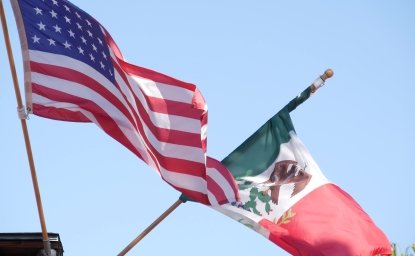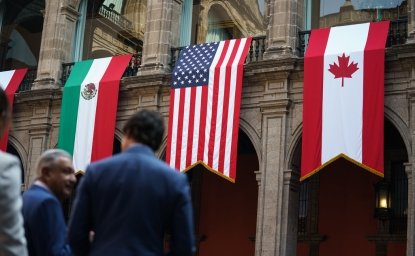The study, by Erik Lee and Christopher E. Wilson of the Border Research Partnership, produces two interesting charts (which we have cut and pasted below). The problem is that they present a puzzling discrepency.

The first chart dramatically shows how the value of bilateral trade increased more than four-fold over the past two decades—almost entirely in manufactured goods; services have only increased a bit.
The second chart shows how personal vehicle and pedestrian traffic increased after the signing of the North American Free-Trade Agreement (NAFTA) in 1995, but retreated after 9/11.
The peculiarity is that lorry traffic, which the report states accounts for more than 70% of all bilateral trade, has actually grown slightly.
A reasonable chap might wonder why the value (albeit not volume) of trade can grow so tremendously while the number of border crossings to transport the goods has budged only barely.

How to square the seeming inconsistency? In short: more goods are crammed into lorries, and more valuable goods are flowing northward, particularly by other means than lorries. As Mr Wilson explains in response to our query:
"I take the growth in trade without a corresponding growth in truck traffic to be further evidence of the 'thickening' of the border. That is, with congestion and delays, there is an incentive to be as efficient as possible. Trucks are packing more value in the same space. As evidence, the number of loaded truck containers grew faster than the number of trucks crossings (since the 90s), and loaded containers increased much faster than the growth of empty truck containers."
"It also appear that trade by road has grown at a somewhat slower pace that trade by air, water, rail, or pipeline—again, likely related to the slowdown at the border crossings. Also, Mexico is moving away from industries like apparel and doing more things like flat screen tvs and medical devices. Seems likely that the value/volume ratio could be increasing. And, trade values are not inflation adjusted, so some growth of trade values without corresponding increases in vehicles or tonnage makes sense."
The point of the report is a call to invest more in infrastructure and revise procedures to improve the flow of traffic at border crossings—and thus trade between the countries. Yet what is subtly revealed by the data is that Mexico's economy is becoming more efficient and moving up the value chain.
Read More: http://www.economist.com/blogs/graphicdetail/2012/06/american-mexican-trade/





